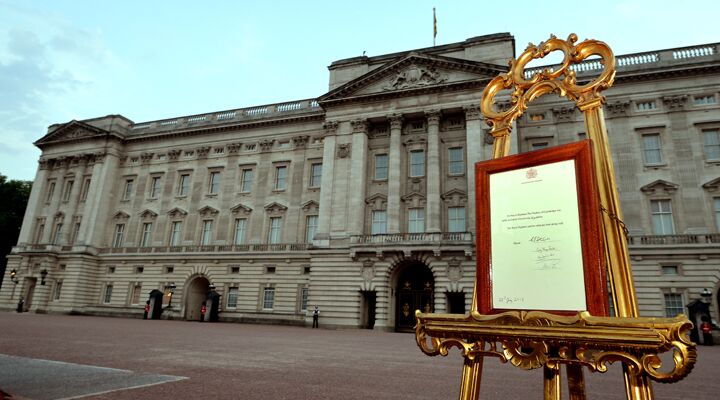
An Heir to the World’s Oldest Throne Is Born!
On Monday afternoon at 4:24 local time, a baby boy was born in London to Prince William and Kate, the Duke and Duchess of Cambridge. The child’s name is not yet determined, but his title is His Royal Highness Prince of Cambridge, and he is the third in line to the British throne after his grandfather Prince Charles and his father.
Devoted journalists, weary from weeks of camping outside St. Mary’s, sprung to life to report on the long-awaited birth. Not just in the United Kingdom, but around the whole world, the crowds around tvs were vast and the interest levels were high.
But to most onlookers, the British throne the boy is heir to is only an interesting relic of a bygone age. It is viewed as a historic curiosity, like one of the last remaining specimens of some endangered, ornate species. Yet, none but the most iconoclastic radicals can resist developing some interest in landmark events for that royal family, such as the expansion it joyously underwent yesterday. In fact, many of the largest television audiences ever in history have assembled for coronations, weddings and other royal family milestones.
People all over the globe are interested in this monarchy, though virtually no one knows the true history and glorious destiny of the British royal throne.
A Guardian article from yesterday, titled “Tracing the Royal Baby’s Lineage,” demonstrates the modern myopia on this topic. The piece tracks the child’s line back through the decades and centuries, but says that the earliest chapter of the royal family’s history was just over a thousand years ago. The royal child is “the 43rd monarch since William the Conqueror obtained the English crown in 1066, but is also 41st in direct line of descent from Egbert, king of Wessex, who ruled from 802 to 839,” the author writes.
Does the royal baby’s ancestry only begin in the ninth century?
Yesterday’s birth presents the UK and the whole world with an opportunity to explore the stirring truth about Britain’s royal family that has been almost entirely lost.
The World’s Oldest Throne
Back in June of 1837, on the day Victoria was crowned queen, a mainstream British journal called the London Sun published an article about the origins of some aspects of the British monarchy. Its author reaches back vastly further into history than today’s Guardian writers and other journalists are willing to. In a description of the royal coronation chair, the article said, “Between the seat and this board is enclosed a stone, commonly called Jacob’s, or the fatal Marble …. History relates that it is the stone whereon the patriarch Jacob laid his head in the plains of Luz” (June 28, 1837).
What possible connection could the royal boy born today have with a rock that the patriarch Jacob rested his head on some 4,000 years ago, in the account recorded in Genesis 28? The “stone of Jacob” or “stone of destiny” is something modern historians and journalists are ignorant about. Yet, it is an absolutely vital key to understanding the true origin and significance of the royal baby’s lineage.
The stone was later placed under England’s authority as it remains today, though it is now on display in Scotland. And this ancient stone has always been an element of the coronation of English monarchs.
The history of Britain’s royal family actually begins with Jacob’s grandfather, Abraham, to whom God made a landmark promise: “I will make of thee a great nation … kings shall come out of thee” (Genesis 12:1-2; 17:1-4). The royal baby boy that was born a few hours ago is a descendant of Abraham, and he, his father, his grandfather and Queen Elizabeth are living proof of the ongoing fulfillment of that promise God made to Abraham!
The promise was reiterated to Abraham’s son Isaac (Genesis 26:3-5), and his grandson Jacob (Genesis 48:3-4), and “the stone of Jacob,” which is still used in British coronation ceremonies, symbolizes elements of that promise! Almost a thousand years after God’s promises to Abraham, Isaac and Jacob, God reiterated them to their descendant David. “And when thy days be fulfilled, and thou shalt sleep with thy fathers, I will set up thy seed after thee … and I will establish his kingdom. He shall build an house for my name, and I will stablish the throne of his kingdom for ever. … And thine house and thy kingdom shall be established for ever before thee: thy throne shall be established for ever” (2 Samuel 7:12-16).
2 Chronicles 23:11-13 describe the coronation of Joash, a king of Judah who lived several generations after King David. The “pillar” mentioned in this passage is none other than the stone that Jacob had laid his head on over a thousand years before (Genesis 28:11-18).
King David’s dynasty continued on from Joash and through many generations to Zedekiah, Judah’s last king before the nation was overthrown by the Babylonian Empire. But it did not end there!
This history of how God kept His unbreakable promise to the patriarchs after the Fall of Judah is astonishing, and it is available. To understand that history, the true significance of the newborn prince’s birth and the jaw-dropping details about the future King who will reign on that same throne for all eternity, request a free copy of The United States and Britain in Prophecy.
